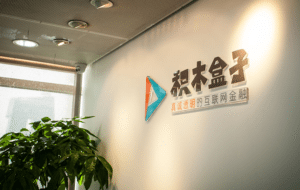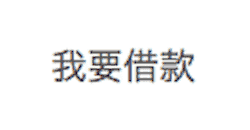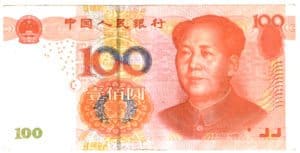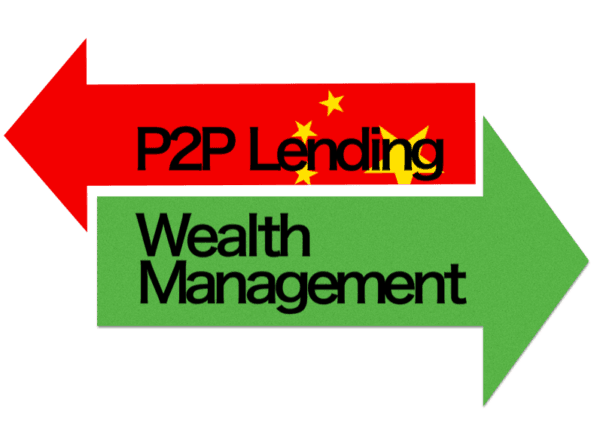Following in the footsteps of Chinese internet giants such as Alibaba, Tencent, and JD.com, leading Chinese P2P platforms have begun evolving into one-stop wealth management platforms.
 Alibaba’s Ant Financial, Tencent’s WeBank, and JD.com’s JD Finance (for some background on these platforms, please refer to a blog post I published in August “If Netflix Started Offering Loans”) are all examples of online marketplaces for wealth management products such as money market funds, insurance annuities, mutual funds, P2P loans, and even private investment trusts or equity crowdfunding projects. As these companies have already amassed hundreds of millions of users through their respective ecommerce, payments, and social media products, it seems only natural for them to monetize this user base by selling financial products provided by third parties.
Alibaba’s Ant Financial, Tencent’s WeBank, and JD.com’s JD Finance (for some background on these platforms, please refer to a blog post I published in August “If Netflix Started Offering Loans”) are all examples of online marketplaces for wealth management products such as money market funds, insurance annuities, mutual funds, P2P loans, and even private investment trusts or equity crowdfunding projects. As these companies have already amassed hundreds of millions of users through their respective ecommerce, payments, and social media products, it seems only natural for them to monetize this user base by selling financial products provided by third parties.
However, we have seen a couple of high profile P2P platforms in China, such as Lufax, Renrendai, and Jimubox, also shift toward this model to capture the additional value from their user base. Let’s take a look at how some platforms are approaching the wealth management marketplace model.
- Touna is a marketplace lending platform founded in 2012 now with over RMB 12.2 billion in originations and just over 2 million registered users. Touna mainly offers secured loans with vehicles and properties as collateral. In June 2015, Touna launched a separate platform that offers higher-yielding investment products such as mutual funds, investment trusts, and even hedge funds. However, according to Chinese law, hedge funds and certain investment trusts are only open to qualified investors with a minimum commitment of RMB 1 million per fund and at least RMB 3 million invested in financial products or a 3-year average annual income of no less than RMB 500,000. Advertised returns for Touna’s fund products are as high as 70%. Of note, GF Securities, one of the first investment banks and brokerage firms in China, is an investor in Touna through its GF Xinde Investment Management subsidiary. Touna’s relationship with GF Securities may have been a major influence in the addition of equity fund sales to its product portfolio.
 Tuandai is a marketplace lending platform founded in 2012 now with over RMB 10 billion in originations and also just over 2 million registered users. Tuandai offers a variety of loan products from unsecured loans to small businesses or secured loans with vehicles, real estate, stocks, or even trust investments as collateral. Recently, Tuandai diversified its investment product offering with the addition of two types of equity investments. One is a hybrid product where the underlying asset is an investment in a private trust that invests in public equity. Investors in this product are guaranteed a minimum 10% annual yield with additional upside based on the performance of the underlying asset. Touna’s other equity investment product is a crowdfunding platform for real estate developments called Fangbaobao, whose direct translation into “housebaby.com” might be considered a bit odd.
Tuandai is a marketplace lending platform founded in 2012 now with over RMB 10 billion in originations and also just over 2 million registered users. Tuandai offers a variety of loan products from unsecured loans to small businesses or secured loans with vehicles, real estate, stocks, or even trust investments as collateral. Recently, Tuandai diversified its investment product offering with the addition of two types of equity investments. One is a hybrid product where the underlying asset is an investment in a private trust that invests in public equity. Investors in this product are guaranteed a minimum 10% annual yield with additional upside based on the performance of the underlying asset. Touna’s other equity investment product is a crowdfunding platform for real estate developments called Fangbaobao, whose direct translation into “housebaby.com” might be considered a bit odd.
 Hongling Capital is one of the earlier lending platforms in China, which launched in 2009 and has only recently exploded in growth. Now touting nearly RMB 100 billion in total origination volume, Hongling Capital is often ranked first in monthly volume by data aggregators for the industry. However, Hongling only reports having about 790,000 users, which is significantly lower than other leading platforms that have generated far less volume. Hongling offers a wide range of loan products in both secured and unsecured categories offering yields of 7-10% to investors, though their homepage advertises returns of upwards of 15-18%. On the wealth management front, Hongling recently launched a “finance supermarket” offering 12 investment options that essentially covers a wide spectrum of wealth management products from low-yielding bank and insurance annuities to high-yielding private trusts.
Hongling Capital is one of the earlier lending platforms in China, which launched in 2009 and has only recently exploded in growth. Now touting nearly RMB 100 billion in total origination volume, Hongling Capital is often ranked first in monthly volume by data aggregators for the industry. However, Hongling only reports having about 790,000 users, which is significantly lower than other leading platforms that have generated far less volume. Hongling offers a wide range of loan products in both secured and unsecured categories offering yields of 7-10% to investors, though their homepage advertises returns of upwards of 15-18%. On the wealth management front, Hongling recently launched a “finance supermarket” offering 12 investment options that essentially covers a wide spectrum of wealth management products from low-yielding bank and insurance annuities to high-yielding private trusts.
 Jimubox is a platform that launched in 2013 and has originated over RMB 11 billion in loans since inception. The platform is backed by well-known entities such as Ventech, a leading VC firm with investments in Europe’s and China’s digital economy space, and smartphone maker Xiaomi. Jimubox primarily works with third-party guarantee companies or micro-loan companies that refer offline borrowers to Jimubox so they may undergo the credit review and funding process online. Jimubox also recently started providing small unsecured loans directly to individuals of up to RMB 20,000 online. Jimubox launched a separate wealth management platform under the Jimufund (www.jimufund.com) brand, which sells a wide variety of fund products such as money market funds, debt type funds, and equity type funds offered and managed by over 30 of China’s leading asset management firms. Jimufund also offers Motif Investing type options where multiple funds are structured together under an investment theme.
Jimubox is a platform that launched in 2013 and has originated over RMB 11 billion in loans since inception. The platform is backed by well-known entities such as Ventech, a leading VC firm with investments in Europe’s and China’s digital economy space, and smartphone maker Xiaomi. Jimubox primarily works with third-party guarantee companies or micro-loan companies that refer offline borrowers to Jimubox so they may undergo the credit review and funding process online. Jimubox also recently started providing small unsecured loans directly to individuals of up to RMB 20,000 online. Jimubox launched a separate wealth management platform under the Jimufund (www.jimufund.com) brand, which sells a wide variety of fund products such as money market funds, debt type funds, and equity type funds offered and managed by over 30 of China’s leading asset management firms. Jimufund also offers Motif Investing type options where multiple funds are structured together under an investment theme.
 Renrendai is one of the more popular marketplace lending platforms. Founded in 2010, it has over 2 million registered users and has originated over RMB 12 billion in loans mainly through online channels. Recently Renrendai made headlines for spending USD 8 million on purchasing the domain name www.we.com. The “we” stands for “wealth evolution,” and Renrendai subsequently launched we.com as its wealth management website. Renrendai essentially restructured and split its website into two so its original renrendai.com domain now serves only borrowers and the new we.com domain serves only retail investors. In addition to purchasing Renrendai loans, customers can now also purchase a variety of fund products, similar to those offered by Jimufund, on the new we.com domain.
Renrendai is one of the more popular marketplace lending platforms. Founded in 2010, it has over 2 million registered users and has originated over RMB 12 billion in loans mainly through online channels. Recently Renrendai made headlines for spending USD 8 million on purchasing the domain name www.we.com. The “we” stands for “wealth evolution,” and Renrendai subsequently launched we.com as its wealth management website. Renrendai essentially restructured and split its website into two so its original renrendai.com domain now serves only borrowers and the new we.com domain serves only retail investors. In addition to purchasing Renrendai loans, customers can now also purchase a variety of fund products, similar to those offered by Jimufund, on the new we.com domain.
 Lufax, formerly a leading marketplace lending platform, was founded in late 2011 and was a first mover among lending platforms to transition to the one-stop wealth management model. Originally incubated by Pingan Insurance Group, Lufax quickly grew in the P2P lending space, originating loans through offline store locations as well as online channels. Leveraging Pingan’s brand power combined with relentless advertising, Lufax has amassed more than 16 million registered users and over 2 million actively investing users as of November 2015.
Lufax, formerly a leading marketplace lending platform, was founded in late 2011 and was a first mover among lending platforms to transition to the one-stop wealth management model. Originally incubated by Pingan Insurance Group, Lufax quickly grew in the P2P lending space, originating loans through offline store locations as well as online channels. Leveraging Pingan’s brand power combined with relentless advertising, Lufax has amassed more than 16 million registered users and over 2 million actively investing users as of November 2015.
In March 2015, Pingan and Lufax announced that the P2P lending portion of Lufax would be restructured under the Pingan Inclusive Finance entity, leaving Lufax to become a pure asset exchange platform that no longer facilitates marketplace lending activities. Now Lufax offers hundreds of investment options including fixed income-type products, various types of equity and debt funds, and insurance annuity products.
In the first 3 quarters of 2015, transaction volume on Lufax totaled over RMB 900 billion with RMB 600 billion coming from institutional investors and RMB 300 billion from individual retail investors. It has been reported that P2P loans now make up less than 10% of Lufax’s transaction volume.
 Furthermore, Lufax announced in August that they will allow other P2P platforms to sell loans on the Lufax platform, but it is unclear how many platforms they have interfaced with so far. Lufax is also exploring the possibility of sourcing international assets and investment opportunities with UBS and Morgan Stanley to package into domestic funds that can be sold to Chinese investors. The firm is preparing for an IPO either on a US or Hong Kong exchange in the near future.
Furthermore, Lufax announced in August that they will allow other P2P platforms to sell loans on the Lufax platform, but it is unclear how many platforms they have interfaced with so far. Lufax is also exploring the possibility of sourcing international assets and investment opportunities with UBS and Morgan Stanley to package into domestic funds that can be sold to Chinese investors. The firm is preparing for an IPO either on a US or Hong Kong exchange in the near future.
As many of these leading platforms move to diversify their product offerings to attract retail investors, it raises the question of whether other platforms will follow suit and perhaps even abandon the marketplace lending model. The motivation behind each platform’s decision to offer investment products in addition to marketplace loans vary. Chinese media has suggested that it is becoming increasingly difficult for platforms to originate loans as market conditions have created an asset drought, driving platforms to explore other products they can offer to yield-hungry investors. I don’t quite buy this argument because I believe, in the slowing Chinese economy, there is an even greater need for capital from borrowers as alternative lending sources dry up. China does not lack in loan assets, China lacks platforms that are capable of lending to the multitude of  underserved borrowers and managing that risk effectively. Therefore the result is the same: platforms that are unable to generate origination volume must now collaborate with third-party asset managers to sell other investment products.
underserved borrowers and managing that risk effectively. Therefore the result is the same: platforms that are unable to generate origination volume must now collaborate with third-party asset managers to sell other investment products.
For some of the platforms outlined above, offering additional investment options in the one-stop wealth management model allows them to capture additional volume and value by leveraging their existing large active investor base. Introducing new wealth management products also induces growth in transaction volume in the near term as investors may try different investment options out of curiosity. As these alternative investments are managed by third parties, it’s quite cost effective for platforms to simply serve as the marketplace for these products and rake in additional revenues through sales. In addition, as yields on marketplace loans are trending downward, offering fund products that have higher advertised returns may prevent a user from taking their money elsewhere to explore better opportunities.
 Lastly, given the uncertain regulatory environment surrounding the online lending space in China, many platforms may be taking preemptive action in diversifying their businesses, in case restrictive policies negatively affect their lending operations. This is especially true for firms that are looking to go public in their next round of financing. In the case of Lufax, completely separating the lending business removes any major uncertainties, and the pure marketplace model will likely boost the company’s eventual public valuation. Since many of the earlier and larger lending platforms in China have completed their Series C rounds of financing, venture backers would likely push for platforms to dilute their emphasis on lending as they prepare for an IPO exit, hoping to circumvent the regulatory uncertainties and increase the probability of a successful IPO at a higher valuation.
Lastly, given the uncertain regulatory environment surrounding the online lending space in China, many platforms may be taking preemptive action in diversifying their businesses, in case restrictive policies negatively affect their lending operations. This is especially true for firms that are looking to go public in their next round of financing. In the case of Lufax, completely separating the lending business removes any major uncertainties, and the pure marketplace model will likely boost the company’s eventual public valuation. Since many of the earlier and larger lending platforms in China have completed their Series C rounds of financing, venture backers would likely push for platforms to dilute their emphasis on lending as they prepare for an IPO exit, hoping to circumvent the regulatory uncertainties and increase the probability of a successful IPO at a higher valuation.
I believe we will continue to see this trend of platforms transitioning to the wealth management marketplace model, especially amongst the top platforms that have large investor user bases where demand for investment products far outweighs supply of marketplace loans. These platforms have likely spent many marketing dollars on building their user bases, and it makes complete sense to capture this value by offering other investment products if they are unable to keep up with loan originations to meet demand. Selling investment products offered by licensed and well-known fund managers is the most cost-effective and scalable method to address these issues.
It will be unfortunate if it comes to pass that these platforms completely abandon the marketplace lending model in favor of these other products, instead of working harder to improve origination methods and continuing to facilitate loans to highly underserved borrowers in China.
 Spencer Ang Li has served as Fincera’s Vice President of Product since June 2015 and as Chief Executive Officer for Fincera’s multiple product development subsidiaries since March 2014. Prior to joining Fincera, Mr. Li was an Investment Banking Analyst at Cogent Partners in New York, a sell-side advisor for private equity secondary transactions, from 2011 to 2014. During his tenure at Cogent, Mr. Li conducted fund due diligence, managed marketing processes, and participated in the sale and transfer of nearly $2 billion in limited partnership interests on behalf of public pensions, large regional banks, asset managers, and other financial institutions. Mr. Li received a BS in Economics and BA in Psychology from Duke University in 2011.
Spencer Ang Li has served as Fincera’s Vice President of Product since June 2015 and as Chief Executive Officer for Fincera’s multiple product development subsidiaries since March 2014. Prior to joining Fincera, Mr. Li was an Investment Banking Analyst at Cogent Partners in New York, a sell-side advisor for private equity secondary transactions, from 2011 to 2014. During his tenure at Cogent, Mr. Li conducted fund due diligence, managed marketing processes, and participated in the sale and transfer of nearly $2 billion in limited partnership interests on behalf of public pensions, large regional banks, asset managers, and other financial institutions. Mr. Li received a BS in Economics and BA in Psychology from Duke University in 2011.


